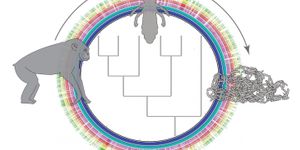Viral Fossils Reveal Immune Capabilities of Our Ancestors
How did our ancient ancestors wipe out a primordial virus 11 million years ago? Could modern humans harness this technique to fight modern viruses scientists struggle to find an answer for? Scientists from Rockefeller University want to answer these questions and apply the solutions to modern public health issues.
"Analyzing viral fossils can provide a wealth of insight into events that occurred in the distant past," said senior author of new eLife study Paul Bieniasz. "In particular, this study is an example of how viruses themselves can provide the genetic material that animals use to combat them, sometimes leading to viral extinction."
Bieniasz and his team from Rockefeller University studied retroviral fossils left by human endogenous retrovirus T (HERV-T), which first appeared in primates nearly 25 million years ago and plagued the population for over 10 million years before it was finally eradicated. Ancient primates did not have the World Health Organization, the Centers for Disease Control and Prevention, or Doctors Without Borders. So how did they do it?
Retroviruses are unique to other viruses because of their ability to be saved in fossils, but they aren’t fossils like one might think of a mosquito in amber or a paw print on a piece of rock. Instead, retroviruses can be preserved in the genome of their hosts; part of their life cycle includes inserting genetic material into the host genome.
Researchers now have a near-complete catalog of HERV-T fossils in old-world monkey and ape genomes. While little evidence of the ancient HERV-T virus exists today, modern human genomes contain a gene relating to the virus that provided a clue as to how ancient primates eradicated it.
"Our analyses suggested that HERV-T likely used a cell-surface protein called MCT-1 to bind to cells and infect ancient old-world primates," explained first author Daniel Blanco-Melo.
The gene fossilized in modern humans but absent in ancient primates “encodes a well-preserved envelope protein that blocks retroviral infection by depleting MCT-1 from cell surfaces.” Whenever primates began to produce this gene, this was likely the time the eradication of HERV-T began.
"It appears this gene was integrated into the ancestral primate genome around 13 to 19 million years ago, and we believe it was around this time that the function of this gene switched," Blanco-Melo said. "Ancestral hominids evolved a defense mechanism against HERV-T, using the virus's own gene against itself, eventually leading to its extinction."
For now, Bieniasz, Blanco-Melo, and the other researchers have a clearer understanding of how ancient primates evolved the ability to manipulate viral gene function to protect themselves from infection. The next step is investigating whether a similar method could be possible for protecting modern humans from modern viruses.
Source: Rockefeller University









